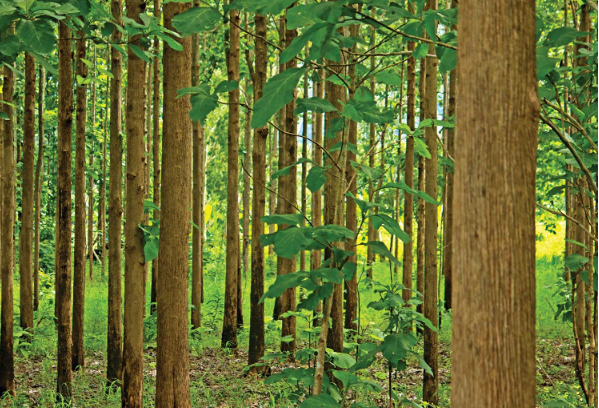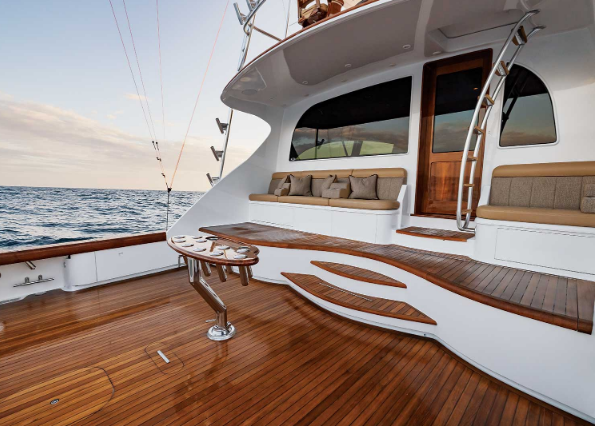
As Burmese teak vanishes from global markets, builders face
soaring prices, supply shortages, and a growing shift toward
synthetic and plantation alternatives
It’s been called the “king of woods.” Long revered for its
unmatched beauty and durability, teak has been a prized lumber
for centuries. As with most precious resources, the history of
this exotic hardwood has been anything but stable. Now, the
global teak industry is at a critical juncture as geopolitical
constraints have resulted in unprecedented supply-chain issues
and disruption in the boatbuilding industry. What began as
another temporary disruption on the tail end of the COVID
pandemic has now erupted into a full-scale crisis for builders
and potential buyers alike. Once a cornerstone of high-end
marine craftsmanship, true Burmese teak has largely vanished
from the US and European markets.
For suppliers, builders and buyers, the dilemma is clear but not
easy—pay exorbitant, inflated prices for the dwindling supply of
true Burmese teak or turn to less-desirable alternatives, as the
highly sought-after wood becomes one of the industry’s most
precious commodities. Although its history is riddled with
struggle and controversy, the future of traditional teak is more
uncertain than ever, leaving the industry navigating uncharted
waters and faced with a moral dilemma of staying true to
tradition or adapting to a changing landscape.

Teak’s Troubled Past
While the present crisis marks the most severe shortage on
record, it’s hardly the first disruption to affect the flow of
this prized hardwood. The challenges facing the industry now are
part of an ongoing, tangled narrative, much like the long,
rocky, and unstable past of the teak trade.
......
......
......
EU Trade Bans Teak Import
While the EU immediately banned the import of Burmese teak, the
US allowed for teak that had already been cut to be shipped into
the country. This dampened the full impact of the ban on the US
market for several years, as teak already in the “system” was
still readily available. “From stump to boat, the timeline for
teak to reach the end user is about two to three years from the
time it was harvested,” Matt says. Although prices increased
almost immediately following the ban, the pre-cut teak continued
to enter the market and lulled many into viewing the situation
as just the latest chapter in the volatile world of the teak
trade. For both suppliers and builders, it wasn’t until 2023
that the industry started to feel the pinch as supplies of
pre-cut teak started to dry up.
For nearly 50 years, Release Marine has handcrafted some of the
best fighting chairs and accessories in the industry, building
its reputation on quality products and customer satisfaction.
Relying primarily on pure Burmese teak for the majority of its
business, Release Marine has been one of the largest consumers
of teak lumber in the US for years. Matt Hecht, president of
Release Marine, explains what seems to be a common thread among
teak’s major buyers.
“By 2023, it became almost impossible to find the proper
lengths, widths and thicknesses we need,” he says. Boatbuilders
and companies such as Release Marine that once relied on large,
single-piece teak boards for yacht decking and high-end
furniture are now forced to work within different constraints.
“We used to get 12-plus-inch-wide, 12-foot-long boards, which
all of our products are designed around,” Hecht recalls. “Now
that’s almost impossible to find. We’re making do with shorter,
narrower and thinner boards, which means more seams, more labor
and ultimately a lot more time to ensure the same look and
quality that we’re known for.”
The transition away from Burmese teak has led to an increased
reliance on plantation-grown teak. “Decades ago, people
recognized teak’s value and started farming it in Central
America, Africa, other parts of Asia and even in the Caribbean,”
Hecht explains. “Now we’re finally seeing those efforts pay off,
but plantation teak is still not a perfect substitute.”
Unlike Burmese teak, which was the standard for decades,
plantation teak trees are generally harvested younger, resulting
in smaller logs that produce shorter, narrower and thinner
boards. Additionally, the physical characteristics of plantation
teak vary depending on soil composition, climate and growth
conditions. “The trees from Burma were old-growth trees grown in
mineral-rich volcanic soil. The trees coming from plantations
now are younger with a much wider variation in the color and
density of the grain pattern. That difference matters for board
sizes, but mainly impacts the ability to maintain the look that
everyone wants,” Hecht says.
Unsurprisingly, with Burmese teak no longer available and the
demand for plantation teak growing, its price has surged. “A few
years ago, you could buy plantation teak for less than half the
price of Burmese teak. Now, with supply dwindling and demand
rising, plantation teak costs the same, if not more, despite its
drawbacks,” Hecht adds.
Despite these hurdles, teak remains an irreplaceable material in
marine and luxury applications due to its natural oil content,
weather resistance and aesthetic appeal. As Hecht notes, “even
though plantation teak isn’t exactly what we had before, it’s
still teak. It still has the characteristics that make it
desirable, and there’s no replacement for the depth and natural
beauty of real wood once it’s finished.”
The Future of Teak’s Use in the Marine
Industry
Emerging from the metaphorical ashes of the imperiled teak
industry is the promising, yet controversial, option of faux
teak. Including both paint-based solutions and synthetic decking
materials, this artificial option gives the appearance of real
teak and has existed for decades.
Josh Everett, owner of Everett Nautical Designs, has specialized
in painting faux teak for roughly a decade and is employed by
some of the most prominent builders in the sport-fishing and
mega-yacht markets. As suspected, Everett’s business is booming.
“I have no life. I am always on the road,” he states. “We have
to turn down more work than we can take on at this point. Our
goal is to imitate nature, and to do that well, it takes time.
To keep that level of quality, I’ve actually had to dial my
business back.” As the faux-teak market explodes, Everett
highlights how the ever-tumultuous teak industry has forced even
the most ardent purists to explore synthetic options. “A lot of
builders are still on the fence about faux teak,” Everett
states. “It has taken a long time for these guys to come around,
but the inflated prices of teak and the increased quality of the
faux-teak options available on the market have really forced
their hand. It really will be interesting to see where the
market goes from here.”
Looking ahead, two factors could reshape the teak industry,
according to several industry leaders grappling with the
uncertainty surrounding the teak trade. First, if opposition
forces were to topple the military regime in Myanmar, a newly
recognized government could reopen trade channels with the US
and EU, potentially revitalizing the flow of Burmese teak.
Second, although the future of US trade policy remains a wild
card, many in the industry hope Trump will loosen restrictions
on teak importation. They also recognize such considerations may
not be a high priority and that sanctions proposed by the Trump
administration may further delay a solution.
For now, companies and consumers are navigating a rapidly
evolving landscape with no clear solution in sight. With Burmese
teak still being strangled from the supply chain, boatbuilders
and suppliers are sourcing from a patchwork of global providers
that offer an ever-dwindling supply of Burmese teak or
less-desirable plantation teak, each presenting its own
challenges.
And while purists remain committed to natural teak, many
industry insiders agree that a shift to teak alternatives is
already underway. Either way, the final tale of the “king of
woods” remains untold.
......
Source:
marlinmag.com